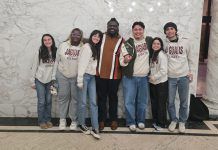Ten out of the first 20 confirmed United States COVID-19 cases occurred in California, with the first San Diego County case reported on March 9, 2020. Within days, the County of San Diego put out a release which said “planning now helps you act more effectively to protect you and your family if COVID-19 does spread locally”.
When elected officials were asked what a year of hindsight has revealed, they consistently observed that South San Diego was more drastically affected than the rest of the county in part because it was behind the economic curve before a single COVID-19 case was diagnosed.
First and foremost, National City Mayor Alejandra Sotelo-Solis said the pandemic shed light on disparities, and forced people to recognize not everyone was starting at the same point.
One indicator of economic disparities is maintained by local schools: prior to the pandemic, Las Palmas elementary school, one of 10 in the National School District had a student population where 100% of students met low-income criteria.
Currently, San Diego county currently sits at 8% unemployment, about average for the state of California yet San Diego Association of Governments Senior Economist Stephanie Guichard said 81% of pandemic-related job loss in National City has affected women who work in retail and tourism and often have young children.
City Councilmember Jose Rodriguez, elected to the dais in 2020 said the pandemic highlighted inequality and is a predictor of which families— those who rely on low-wage workers without adequate health are— will struggle for years to come.
“Throughout the pandemic, the income disparity was magnified. I saw 500 cars at a time lining up at food distributions to pick up groceries. Those folks that are still struggling economically are going to have a very difficult time getting out of the COVID recession,” Rodriguez said.
Even now, over a year since the pandemic first hit San Diego county, National City holds the dubious record of one of the highest continuous case rates across the county.
“The lesson learned, room for improvement is getting better at recognizing disparities so they can be handled before a crisis hits,” Sotelo-Solis said.
From the beginning, she said, community-level problems stemmed from the federal government and testing was neither supported nor evenly distributed.
“There was no unified message or even encouragement, suggestions of what could be done. We recognized all the testing was going to certain places,” Sotelo-Solis said, and that lack of focus trickled down to county level.
Furthermore, she said, data came down ‘piecemeal’ from the county.
“More than anything, early on, we needed data and we needed a commitment from the county to test in our community. There was no consistency at the beginning of the process,” Sotelo-Solis said.
On the other hand, she said, although there was a notable outcry from residents across the county wanting to know exactly where breakouts were happening, having too much identifying information might have led to discrimination.
Leaders had to learn what information to release and how it would best benefit residents while also slowing the spread of the virus.
Another challenge, she said, was attempting to provide direction for local residents while living under the same constraints as they were.
There was no divide, no way for government leaders to isolate and create policy while working with limited information in a physically distanced setting and, to top it off, residents were desperate to open up shops and support their families.
People started to question who was making decisions, she said, mostly because they wanted consistency.
“The one thing I give Gov. Gavin Newsom is he bases his decisions on testing levels and they’re data driven. But, for the layperson who may not understand why a nail salon has one set of requirements versus a movie theater, a restaurant versus a gym, it takes explaining and when the person is working, trying to put food on the table, avoid getting sick because they’re scared they’re going to die without health care, all those fears and issues are compounded,” Sotelo-Solis said.
Trying to set policy with moving goalposts was challenging, she said.
Another lesson learned, then: establish policy in a way that residents understand directives might change.
Coming out of the pandemic, the vaccine rollout has been a struggle in this hard-hit region. Vaccine points of distribution were initially structured at county level so a resident from one neighborhood with a relatively benign case rate can make an appointment in a part of town that is very hard hit, essentially reducing the number of vaccinated individuals in those highly infected areas.
Sotelo-Solis spoke to the first three people in line to receive their vaccines on the first day they were available and one came from as far as Carlsbad.
“So, now there’s a whole new phase and we’re still behind. You can put distribution points all over but if they’re not going to be prioritized by zip code then the residents are really missing out,” Sotelo-Solis said.
She calculated aloud: at 500 shots per day and with a population of 60,000, “in 15 weeks, we’d be close to herd immunity” and that could be accomplished with just one locally-dedicated distribution point.
Recently, Rodriguez said, the county has done a better job proactively pushing out the vaccine to harder hit communities as well as changing how Coronavirus Aid, Relief, and Economic Security Act funding, also known as the CARES funding was distributed.
“A big issue we had was the CARES act funding came through the county; it was their job to distribute it throughout the region. I thought it was unjust that funding was not emphasized enough in hardest hit communities,” Rodriguez said.
As National City has more essential workers, higher infection rates and denser, often multi-generational housing, he believes funding should have been higher and reflected an equitable, if not equal distribution of funds.
And yet, there is a sense of being somewhat on the other side.
This year, the city falls under new regulations that qualify smaller cities to apply for direct funding rather than being lumped in with other municipalities.
“I’m glad to see in this new round, we qualify for individual funding ourselves and don’t need to go through the county mechanism to access that funding,” Rodriguez said.
The County Board of Supervisors has already agreed to set aside $30 million to help small businesses spend another $20 million for essential workers, and is holding virtual community forums to solicit feedback on plans.
Philanthropic partners are also stepping up, Sotelo-Solis said, banding together to help at a local level.
“Even now, as we go beyond COVID-19, we need to recognize we still have that disparity and have to help each other,” Sotelo-Solis said.
“We all felt that there would be a light at the end of the tunnel. There’s been these efforts of helping humanity, early on everyone was all about making masks… people started food banks and pantries in their own neighborhoods… we rethought how we kept in contact with each other,” Sotelo-Solis said.















